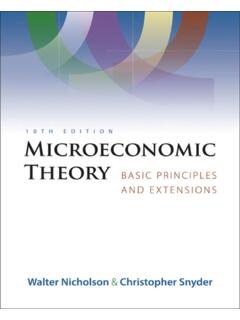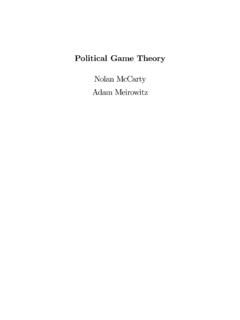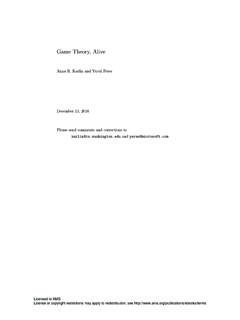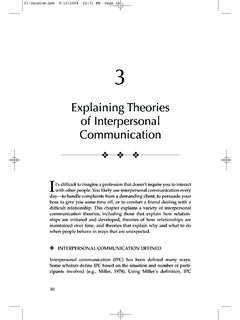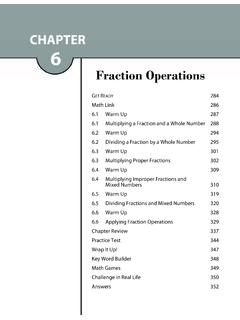Transcription of Chapter 12 Repeated Games - MIT OpenCourseWare
1 Chapter 12 Repeated Games In real life, most Games are played within a larger context, and actions in a given situation affect not only the present situation but also the future situations that may arise. When a player acts in a given situation, he takes into account not only the implications of his actions for the current situation but also their implications for the future. If the players arepatient and the current actionshavesignificant implications for the future, then the considerations about the future may take over. This may lead to a rich set of behavior that may seem to be irrational when one considers the current situation alone. Such ideas are captured in the Repeated Games , in which a "stage game" is played repeatedly.
2 The stage game is Repeated regardless of what has been played in the previous Games . This Chapter explores the basic ideas in the theory of Repeated Games and applies them in a variety of economic problems. As it turns out, it is important whether the game is Repeated finitely or infinitely many times. Finitely- Repeated Games Let = {0 1 } be the set of all possible dates. Consider a game in which at each players play a "stage game" , knowing what each player has played in the past. Assume that the payoff of each player in this larger game is the sum of the payoffsthat he obtains in the stage Games . Denote the larger game by . Note that a player simply cares about the sum of his payoffs at the stage Games .
3 Most importantly, at the beginning of each repetition each player recalls what each player has 199 200 Chapter 12. Repeated Games played in each previous play. A strategy then prescribes what player plays at each as a function of the plays at dates 0, .. , 1. More precisely, let us call the outcomes of the previous stage Games a history, which will be a sequence ( 0 1).A strategy in the Repeated game prescribes a strategy of the stage game for each history ( 0 1) at each date . For example, consider a situation in which two players play the Prisoners Dilemma game, 5 5 0 6 6 0 1 1 ( ) twice. In that case, ={0 1} and is the Prisoners Dilemma game. The Repeated game, , can be represented in the extensive-form as 111 212121212 CDCDCDCDCDCDCDCDCDCDCDCDCDCDC D22 121 2 121 2 121 2 121 2 C D C D C D C D C D C D C D C D C D C D C DC D C D C DC D 101055 111166 55006611 111166121277 66117722 1010111155 66 111112126677 55660011 66771122 Now at date =1, a history is a strategy profile of the Prisoners Dilemma game, indicating what has been played at =0.
4 There are four histories at =1: ( ), ( ), ( ),and ( ). A strategy is to describe what the player plays at =0,and what he plays at each of these four histories. (There are 5 actions to be determined.) This is rather clear in the extensive-form game above. Let us compute the subgame-perfect equilibrium of ; the equilibrium is depicted in the figure. has four proper subgames, each corresponding to the last-round game 201 FINITELY- Repeated Games after a history of plays in the initial round. For example, after ( ) in the initial round, we have subgame 11 22 C D C D C D 105 116 10115 6 whereweadd 5toeachplayer spayoffs, corresponding to the payoff that he gets from playing ( ) in the first round. Recall that adding a constant to a player s payoff does not change the preferences in a game, and hence the set of equilibria in this game is the same as the original Prisoners Dilemma game, which possesses the unique Nash equilibrium of ( ).
5 This equilibrium is depicted in the figure. Likewise, in each proper subgame, we add some constant to the players payoffs, and hence we have ( ) as the unique Nash equilibrium at each of these subgames. Therefore, the actions in the last round are independent of what is played in the initial round. Hence, the players will ignore the future and play the game as if there is no future game, each playing . Indeed, given the behavior in the last round, the game in the initial round reduces to 6 6 1 7 7 1 2 2 whereweadd 1toeachplayer spayoffs, accounting for his payoff in the last round. The unique equilibrium of this reduced game is ( ). This leads to a unique subgame-perfect equilibrium: At each history, each player plays.
6 What would happen for arbitrary ? The answer remains the same. In the last day, , independent of what has been played in the previous rounds, there is a unique Nash equilibrium for the resulting subgame: Each player plays . Hence, the actions at day 1 do not have any effect in what will be played in the next day. Then, we can consider the subgame as a separate game of the Prisoners Dilemma. Indeed, the 202 Chapter 12. Repeated Games reduced game for any subgame starting at 1is 5+1+ 1 5+1+ 2 0+1+ 1 6+1+ 2 6+1+ 1 0+1+ 2 1+1+ 1 1+1+ 2 where 1 is the sum of the payoffsof from thepreviousplays at dates 0 we add for these payoffsand 1for thelastround payoff, all of which are independent of what happens at date 1.
7 This is another version of the Prisoner s dilemma, which has the unique Nash equilibrium of ( ). Proceeding in this way all the way back to date 0, we find out that there is a unique subgame-perfect equilibrium: At each and for each history of previous plays, each player plays . That is to say, although there are many repetitions in the game and the stakes in the future may be high, any plan of actions other than playing myopically everywhere unravels, as players cannot commit to any plan of action in the last round. This is indeed a general result. Theorem Let be finite and assume that has a unique subgame-perfect equi -librium .Then, has a unique subgame-perfect equilibrium, and according to this equilibrium is played at each date independent of the history of the previous plays.
8 The proof of this result is left as a straightforward exercise. The result can be illustrated by another important example. Consider the following Entry-Deterrence game, where an entrant (Player 1) decides whether to enter a market or not, and the incumbent (Player 2) decides whether to fight or accommodate the entrant if he enters. 1 Enter 2 Acc. (1,1) X Fight (0,2) (-1,-1) ( ) Consider thegamewhere theEntry-Deterrencegameisrepeated twice, and allthe previous actions are observed. This game is depicted in the following figure. 203 FINITELY- Repeated Games 1 Enter 2 Acc. 1 Enter 2 Acc. (2,2) X Fight X Fight Acc. 2 Enter 1 (1,3) (1,3) (0,0) 1 Enter 2 X (0,0) X Fight (-1,1) (0,4) (-1,1) (-2,-2) As depicted in the extensive form, in the Repeated game, at =1,there are three possible histories: , ( ),and ( ).
9 A strategy of Player 1 assigns an action, which has to be either Enter or ,to be played at =0andactionto be played at =1for each possible outcome at =0. In total, we need to determine 4 actions in order to define a strategy for Player 1. Similarly for Player 2. Note that after the each outcome of the firstplay, theEntry-Deterrencegameis played again, where the payoff from the first play is added to each outcome. Since a player s preferences do not change when we add a number to his utility function, each of the three Games played on the second day is the same as the stage game (namely, the Entry-Deterrence game above). The stage game has a unique subgame perfect equilibrium, where the incumbent accommodates the entrant and the entrant enters the market.
10 In that case, each of the three Games played on the second day has only this equilibrium as its subgame perfect equilibrium. This is depicted in the following. 1 2 Enter X Acc. Fight 1 2 Enter X Acc. Fight (1,3) (0,0) (2,2) 1 2 Enter X Acc. Fight (0,0) 12 Enter X Acc. Fight (-1,1) (1,3) (0,4) (-1,1) (-2,-2) Using backward induction, we therefore reduce the game to the following. 204 Chapter 12. Repeated Games 1 Enter 2 Acc. (2,2) X Fight (1,3) (0,0) Notice that we simply added the unique subgame-perfect equilibrium payoff of 1 from the second day to each payoff in the stage game. Again, adding a constant to a player s payoffs does not change the game, and hence the reduced game possesses the subgame-perfect equilibrium of the stage game as its unique subgame perfect equilibrium.










